On the southern tip of Galiano Island, a diagonal, 28-kilometre-long strip of land suspended off the coast of southern British Columbia, a thicket of Douglas fir thins to a small clearing overlooking Active Pass. A layered vista of darkly green Gulf Islands — the archipelago of which Galiano is a part — extends in every direction. Directly below the viewpoint, the blare of a ferry’s horn alerts us to a boatload of passengers headed for the nearby city of Vancouver.
“This is the spot,” says Andrew Simon, a naturalist. “I’ll let you find it.”
A mosaic of ground cover plants makes a living carpet. I recognize only one of them: tiny spears of common pincushion moss spring from their leafy bedding, patched together against the dirt and bedrock. Then I spot a yellowy moss turned crisp from a dry summer and ask Simon if that’s the one we’re looking for.
He furrows his brow. “No, that’s Niphotrichum elongatum,” he says. It’s another of the more ordinary rock mosses of the Pacific Northwest coast. Simon has brought me here in search of Triquetrella californica, a far rarer moss. “It’s a small, inconspicuous thing,” he says. “But it is beautiful.”
I look around for a few moments longer before declaring that I give up. Simon crouches on his hands and knees, the tip of his nose inches from the soil as he holds back walnut-colored tresses. “Look at how abundant it is around here!” he says. “We’re seeing it everywhere.”
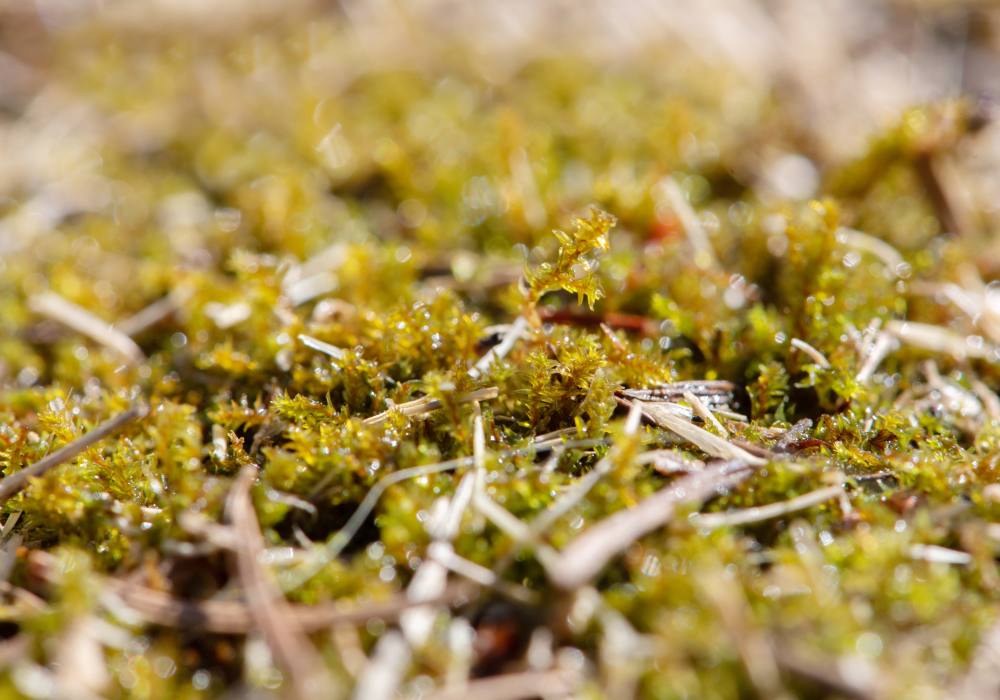
On this sunny July day, Triquetrella californica looks like little more than a sprinkling of dried ramen noodle crumbs. But, like ramen, the moss is made to be hydrated. At Simon’s suggestion, I pour a sip of water over the desiccated sprigs, and they instantly animate into a miniaturized copse of limey-green spires with leaves growing out in ranks of three — hence the tri in Triquetrella. The nondescript plant has not only come back to life, it has also, with Simon’s help, erupted into my consciousness.
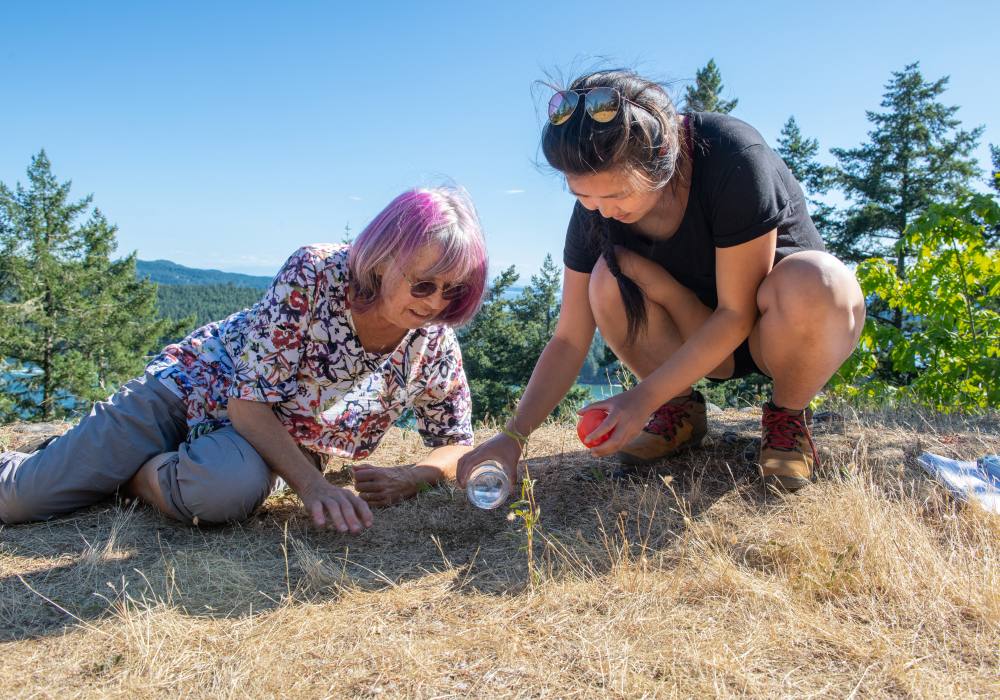
“You’ve found the rarest moss in Canada,” says Simon. “There’s your sensationalist headline.” Simon is being facetious — an exacting scientist, he would hate to read an overblown valuation of the modest moss. Yet his superlative was true. At the time, this rocky outcrop was the only place the plant was found north of the Canada-U.S. border. Since then, a friend of Simon’s has found a patch near Comox on Vancouver Island.
As we step back into the forest, I test Simon’s knowledge further, pointing to plants along the hiking path. He rapturously rattles off the Latin names of each species. When I naively point to a spindly bush with what looks like black beans dangling from its otherwise bare branches, Simon informs me it is Scotch broom, Cytisus scoparius, a widespread invasive species. I feel a flush of embarrassment for not knowing even the most commonplace of plants. Though life teems all around us, most of us can scarcely put a name to the nearest animal, vegetable or mineral. When Simon walks in the woods, he’s among old friends.
For the past six years, the thin 36-year-old with a macro-lens Olympus point-and-shoot forever around his wrist has been on a quixotic mission to document every last species on Galiano Island, from the lone pair of elk that swam ashore one day from another of the Gulf Islands, to the orb spiders guarding glistening webs, to the oysters clustered beneath the tides. His project spans animal, plant, fungal and protozoan life forms, and includes marine life up to a kilometre offshore and down to a reef 120 metres below the surface, as well as every bird that flies overhead. Biodiversity Galiano, better known as BioGaliano, is among the more ambitious, comprehensive, and grassroots biological inventories being carried out anywhere on Earth.
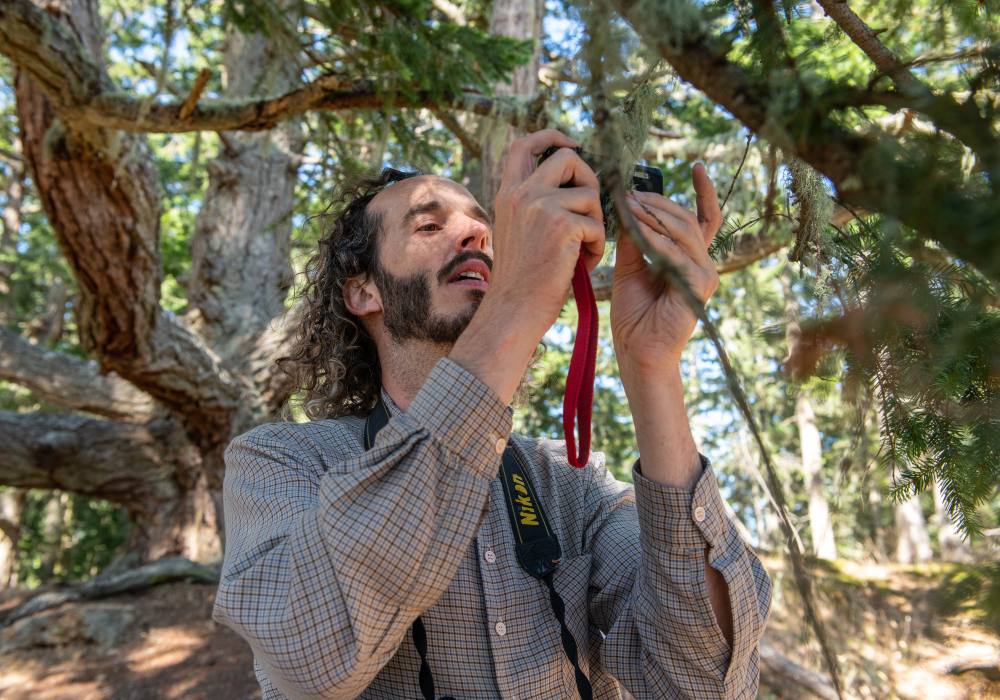
Scientifically, BioGaliano is a formidable ledger of scientific knowledge and a baseline against which to measure ecological change in the future. In its first few years, the project has already documented a host of species never before recorded on the island, and in some cases, like Triquetrella californica, entirely new to Canada.
At least as importantly, Simon has given the likes of sideband snails, snowberries and fairy slippers a space in the conscious minds of Galiano Island’s human residents. Putting a name to something is fundamentally an act of acknowledgment — the starting point for the kind of intimate relationship that can inspire us to protect the natural world. Judith Winston, a former commissioner with the Singapore-based International Commission on Zoological Nomenclature, the body that oversees the scientific naming of animals, puts it bluntly: “If a species doesn’t have a name, it doesn’t exist. If it doesn’t have a name, it’s never going to be conserved.”
Simon may know about an impressive number of things living beneath the forest canopy now, but his dedication to understanding nature didn’t really kick in until his early 20s. Growing up by the shores of Lake Huron in Ontario, he always held an interest in the wild world, but as a young man he became what he describes as a disillusioned “political activist type.”
He spent his latter teens and early 20s as a volunteer with Canada World Youth and on organic farms, bouncing around such destinations as Brazil, Hawaii and Mexico. Finally, in 2007, he landed on the property of Trevor Goward in B.C.’s dry interior near Kamloops.
Goward is a passionate gardener, a self-taught lichenologist, and a researcher with the University of British Columbia. He calls himself a bit of a hermit, but Goward is kind and affable, the sort of big-picture thinker that can tie every modern-day crisis back to the avarice of a capitalistic worldview.
One of the tasks Goward assigned to Simon was transcribing voice recordings that Goward took while in the field. Parmeliopsis ambigua, Candelaria concolor, Agonimia tristicula. As the euphony of Latin names rolled over him, Simon found that the role of scribe offered an unexpected doorway into Goward’s worldview.
“I met Trevor and I realized that there’s a lot more stories out there than just the human story,” Simon says. Learning the names of mosses and lichens allowed him to focus his attention outward to the exuberant richness of the planet’s diverse living things rather than dwell on his inner discontent.
A piqued passion for biodiversity eventually led Simon to focus on environmental studies and cognitive science at Quest University Canada in Squamish, B.C., and his experience with Goward helped him land an internship on Galiano Island in 2010. After a summer spent pulling weeds, propagating native plants, and teaching environmental education classes for the Galiano Conservancy Association, a local non-profit dedicated to ecological stewardship, Simon set to work conducting biodiversity surveys on the island.
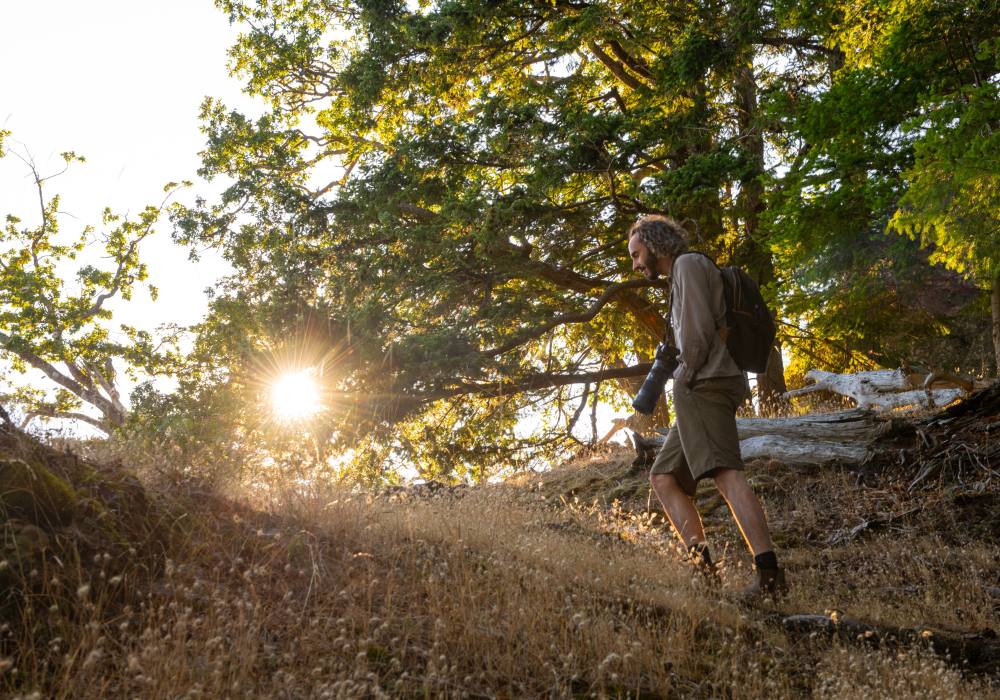
It proved to be a fascinating place for a budding naturalist. Hidden in the rain shadow of Vancouver Island and Washington state’s Olympic Mountains, Galiano is the driest of the Gulf Islands, but it used to be even drier. Nine thousand years ago, the tilt of the Earth’s axis placed the islands at a more southerly latitude than they are today, giving them a semiarid climate. The planet’s shifting alignment gradually moved the archipelago northward, and around 5,000 years ago, the B.C. coast became inundated with rain. Since Galiano Island was still sheltered between mountain ranges, though, it retained some of the species and ecosystems of its warmer past.
Today, the island is a patchwork of rain-loving evergreens like western red cedar and dry-meadow trees like Garry oak. The island is within the unsurrendered territories of the Penelakut and other Coast Salish Nations, but settlers from elsewhere began arriving in the 19th century. Most of the 1,400 current year-round residents have made homes of scattered cabins in the woods, and over the summer months the island is flush with visiting kayakers, campers and hikers. Come nightfall, eerie darkness envelops land and sea, and the morning is greeted by the scent of evergreens and the chorus of thrush and warbler.
At first, Simon wanted to create a comprehensive field guide to the species found on a large property owned by the Galiano Conservancy. By the time he had written a rambling, 100-page manuscript that hadn’t yet moved beyond marine algae, he realized that there were probably better ways to engage the community in learning about the local biodiversity. Having himself been changed by the process of getting to know his non-human neighbours, he wanted to help the local community deepen its appreciation for the island that he had grown to love.
Around the same time, iNaturalist, a free app that makes it easy for even novice naturalists to identify species, became available. Users can simply upload a photo of drooping purple flowers, for example, and a machine-learning algorithm will spit out a name — Digitalis purpurea, a perennial plant commonly called foxglove — with a high degree of accuracy. The wider iNaturalist community, which includes many experts, confirms the identifications or fills in blanks where the algorithm fails.
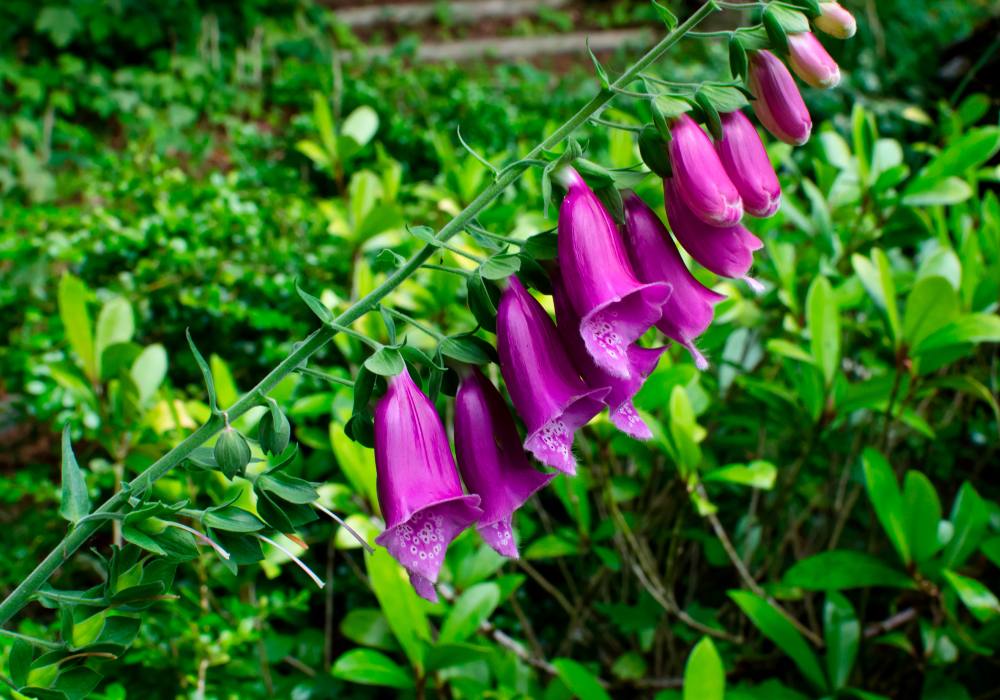
“The first main goal was just initially this obsessive goal of documenting all of the living things,” says Simon. “The second goal was to engage the community in that process and to make biodiversity research more friendly and participatory.”
One of the first steps for the BioGaliano project was collecting the names of every species that had previously been documented on the island. Simon gathered records dating back to 1859 from explorers who had visited the island, as well as findings from local naturalists; he scoured natural history museum archives, and drew on the knowledge of Jeannine Georgeson, a Coast Salish and Sahtu Dene friend who had grown up on Galiano and collaborates with Indigenous knowledge keepers. In the end, Simon had a list of nearly 2,800 species of animals, plants and fungi known from the island — and a launching point for his mission to identify every species yet to be found.
“It’s like a scavenger hunt,” he says.
Naming and learning names are among the most central elements of language. They are foundational steps in being able to communicate and speak specifically about the world. Toddlers will instinctively repeat the names of the objects that they hear being said around them. In the Old Testament, God parades the animals in front of Adam to be named; in a Mayan creation story, it is the deities who name all life, bringing it out of emptiness and into being.
Our current understanding of the breadth of life forms has roots in the age of exploration that occurred between the 15th and 17th centuries. “People started to make voyages around the world and bring back all kinds of stuff, including plants and animals,” says Winston of the International Commission on Zoological Nomenclature.
Naming is how we began to make sense of what we now call biodiversity. Inundated with new species in the thousands, from dodos to dugongs, scientists needed a standardized way of referring to species across continents and languages. In the mid-18th century, a Swedish species classification expert, or taxonomist, called Carl Linnaeus developed and popularized binomial nomenclature, which remains the official system of scientific naming. A species is identified by its genus, which is shared with any close relatives, followed by a unique specific epithet; the two combined are its species name. For example, human beings: genus Homo (no close relatives currently exist), specific epithet sapiens, species name Homo sapiens.
Once a new species is confirmed by the scientific community, its presence can be added to the grand encyclopedia of recognized life forms. According to the Catalogue of Life, an international effort to create a universal species compendium, there are 2.3 million known species, from microbes to the world’s largest living animal, the blue whale. While calculations are rough, scientists estimate there are another 8.7 million yet to be identified.
Each year, up to 18,000 species are named or renamed, with 2021 adding the likes of the emperor Dumbo octopus and the nano-chameleon, perhaps the world’s tiniest reptile, which can comfortably perch on the tip of your pinkie finger. Many, such as Eunota mecocheila, an iridescent tiger beetle, and Scolopendra alcyona, a rare amphibious centipede, have only a scientific name. With no known common moniker in any language, awareness of these species is likely limited.
While new names are constantly added to the scientific vernacular, an increasing number of species is also being permanently erased from the catalogue. Estimates vary widely, but up to 55,000 species are lost each year from forces such as habitat loss, climate change and pollution — a rate 1,000 times higher than before humans became the dominant influence on the environment. Most of these vanished species are nameless.
A similar pattern of loss is reflected in day-to-day speech. Subjects that carry heavy cultural significance often have a more diversified lexicon. The Scots have an impressive vocabulary for describing bad weather, such as snell for a biting cold that pierces the skin, or drookit for being soaked to the bone; Hawaiians have around 65 words to describe fishing nets and 180 associated with sweet potatoes. In the 2015 revision of the Oxford Junior Dictionary, around 50 nature words, such as “herring,” “lobster” and “otter,” were dropped and replaced with words like “cut-and-paste” and “broadband” — a microcosmic reflection of what holds relevance, and what no longer does, in the modern world. This is exactly the tide of change that Simon is trying to hold back.
It’s October, and a grey sky hints at a future storm as a BioGaliano search party, made up of nine expert and novice species identifiers, myself included, moves into the trees on the southern edge of the island.
With retractable magnifying glasses dangling off necks like pendants, our group treads softly over the soggy forest floor, pausing frequently to examine infinitesimal colonies of life. Previous BioGaliano hunts have focused on insects, fungi and plants, but we are on the lookout for more overlooked branches of the evolutionary tree. Simon has emailed the participants a 21-page document listing every species of lichen (a life form that is a symbiotic fusion of fungi and algae) and bryophyte (mosses and their cousins the liverworts and hornworts) ever recorded on the island (263 lichens, 179 bryophytes). Our mission is to confirm whether the species previously noted in historical records are still out there, as well as to document new discoveries.
But nature is endlessly distracting. Brightly coloured jelly fungi spring from dead wood. One species, sometimes referred to as witch’s butter, grows in clusters on a fallen log like gelatinous orange brains. A forestry student from UBC pops a piece in her mouth and says it just tastes like water.
Pam Janszen, a naturalist who collected her first slime mould more than 25 years ago, spreads a heavy-duty plastic bag on the ground to protect her legs from the damp earth as she kneels to peel back the bark on a rotting log.
“Ooh,” she says with delight. Holding her breath to keep still, she carefully inspects a slime mould through her camera’s macro lens. With the naked eye, I can barely make out minute black baubles standing erect on stems, like alien lollipops. Pulling out a knife, Janszen gently nicks a sample of the mould and stashes it in a metal tin for later identification.
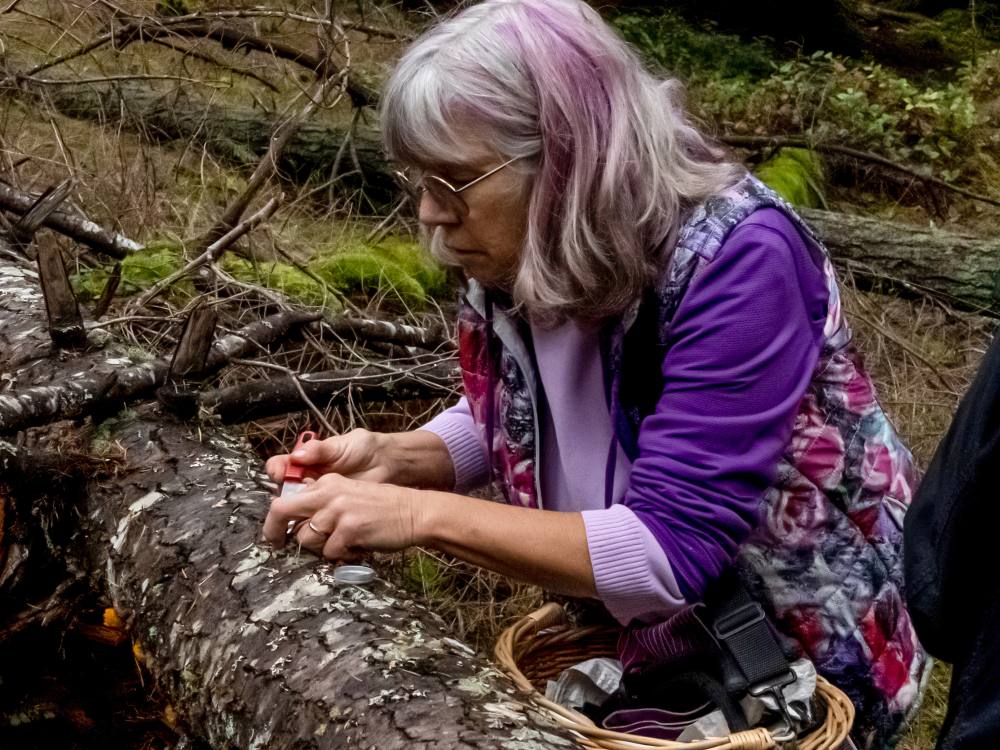
Simon’s knowledge isn’t limitless — altogether he credits over 50 taxonomic experts with assisting the project, each committed to discerning the fractal details of their selected branch of the evolutionary tree. “People that can identify species are often rarer than the species themselves,” says Simon.
Over the years, he has organized various biodiversity missions on Galiano. The specialists convene for a day or a weekend to collectively identify as many species as possible. They’re often joined by interested enthusiasts — BioGaliano’s Facebook page now has over 800 followers, around half of the local population. On iNaturalist, the project has over 500 unique contributors, some of whom are visitors to the island. Together, these participants have marched up forested mounts, waded through swamps, and dived beneath the ocean surface in search of species to add to the island’s biodiversity catalogue.
Wins in the quest came early. In 2016, Olivia Lee, a bryophyte specialist and former collections manager at the Beaty Biodiversity Museum in Vancouver, was hiking on Galiano Island and collecting unfamiliar mosses. A soft, green variety caught her attention, and she collected a sample. After flipping through her guidebook of Pacific Northwest mosses, the specimen remained a mystery. She passed along images of it to other specialists until Richard Zander from the Missouri Botanical Garden determined it was Triquetrella californica — the species that is now among the rarest known mosses in Canada.
“I never thought I would discover something,” Lee tells me in a video call, beaming sheepishly. “I’ve never won the lottery before. It just felt really, really good.”
In 2019, Jessica Kirkwood, a Galiano local, was driving through Bluffs Park on the southern tip of the island when she noticed a heavyset, sienna-colored snake coil and hiss next to her truck. She posted a video of the creature on the Facebook page. At the time, the island’s only known snakes were three species of timid garter snakes and the sharp-tailed snake. The aggressive serpent that Kirkwood saw — with the girth of a muscly arm — stood in stark contrast. Simon sent the video to herpetologists in Canada, who dismissed it as a garter snake. Later, herpetologists in California identified it as a Pacific gopher snake. The last time one had been seen in Canada was in 1957 — on Galiano Island.
Rediscovery of the Pacific gopher snake could potentially usher in new conservation measures. The snake is listed as extirpated — no longer present — in Canada, and if additional herpetologists confirm a population in Bluffs Park, the area could be granted special federal or provincial protection.
By the end of 2021, BioGaliano had documented over 4,000 species in its six years of operation, including 1,241 arthropods, 931 plants, 482 fungi, 264 lichens, 230 mollusks, 186 birds, 83 fish and 42 mammals. They’ve documented over 1,200 species — such as a rare coralroot orchid and an unusual jumping spider — never before recorded on the island, on top of the approximately 2,800 historically identified species. They’ve also confirmed the continuing presence of half the species from the historical roster. Some of the missing species have probably been extirpated, Simon says, but many are rare or obscure enough that they may still be found. One on Simon’s to-find list is Ostrea lurida, also known as the Olympia oyster, an endemic species that Jeannine Georgeson says her family often used to eat.
Driving through a patch of old-growth forest mottled with the gargantuan stumps of even more ancient giants felled by loggers decades ago, Simon and a few other bioblitzers pull over to quickly peek at the mosses and lichens. Dan Tucker, an avid young bryophyte enthusiast from Cortes Island, B.C., shows Simon a shard of decaying wood coated in a manicured lawn of green growth. Despite spending hours staring at mosses by this point, the distinguishing characteristics are still lost on me. “That looks exactly like every other moss,” I remark. Anticipating my question on how the hell he can differentiate this from other mosses, Tucker smiles and says, “After a while, these things sort of start to have an essence.”
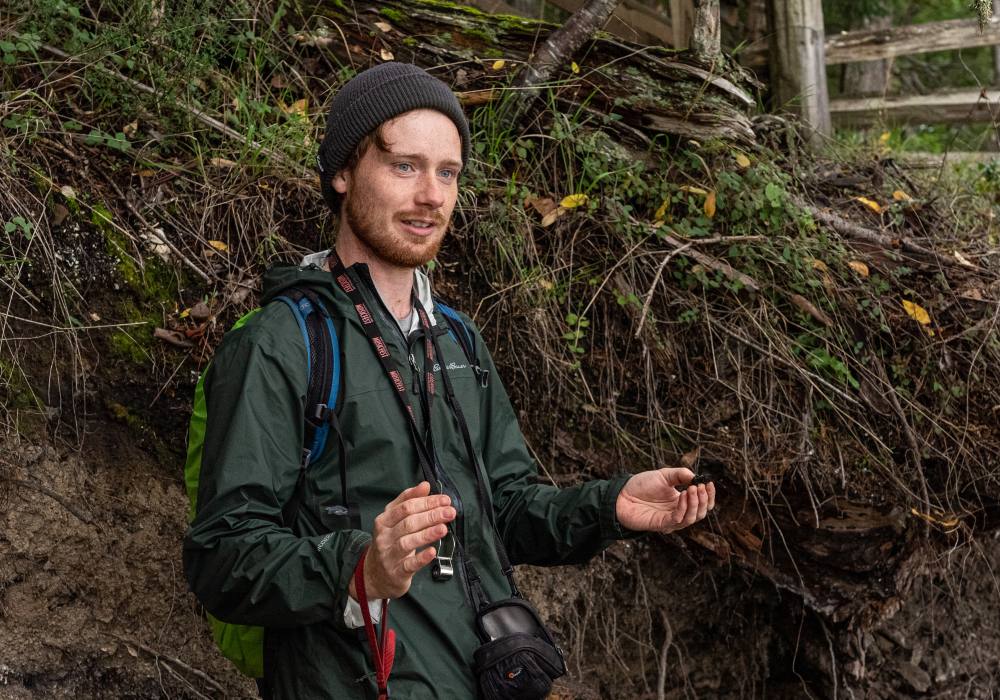
Documenting bryophytes, Tucker tells me, is just something he feels like he has to do — a compulsion. Donna Gibbs, a marine naturalist who has participated in a BioGaliano marine foray, tells me something similar. For three decades, she and her husband made a routine of diving near their home in Port Coquitlam, just east of Vancouver, and recording every species that they saw, from harbour seals to the nudibranchs. “It’s a complete labour of love,” she says.
“I was amazed by the things I could find in my backyard and in my neighbourhood,” says Scott Gilmore, a biologist who is one of Simon’s go-to insect experts, explaining his own motivations. “Whenever I find something and I don’t know what it is, I try and go and work it out. It’s just been a lifelong passion putting names to things.”
Can the rest of us really become more like Simon and his environmental entourage? Goward points to psychologist Howard Gardner’s theory of multiple intelligences, which posits that people can be intelligent in eight different ways. Mozart, for example, was blessed with musical genius; at the age of 14 he is said to have transcribed every note of a 15-minute-long choral piece after listening to it only once. Einstein’s logical-mathematical intelligence revolutionized the way we understand the universe.
In Gardner’s book, Multiple Intelligences: New Horizons, he recalls presenting his theory — which originally included seven intelligences — to a lecture hall of academics. The renowned ecologist Ernst Mayr was in the audience and reportedly commented, “But you’ll never explain Charles Darwin with your taxonomy of intelligences.” Gardner’s next iteration of the theory included an eighth intelligence: the naturalist.
“It’s a special way of recognizing patterns and seeing how they fit together,” says Goward. “There are some people in the world who are simply born naturalists. They see patterns rather than physical things.”
Yet all of us may share in that propensity for nature, in the same way that, while very few people are geniuses like Mozart, nearly everyone appreciates music. The eighth intelligence is written into the human experience. Acclaimed philosopher Erich Fromm described the human instinct to connect with nature and other living beings as biophilia, a term later popularized by naturalist E.O. Wilson. Science writer Carol Kaesuk Yoon builds on that idea in her book Naming Nature. She argues that millennia of foraging for food and fending off predators have carved out a universal capacity to perceive the natural order — a hardwired human instinct she calls the Umwelt. The term stems from a German word meaning “the environment” or “the world around,” but biologists use it to refer to each species’ unique perception or experience.
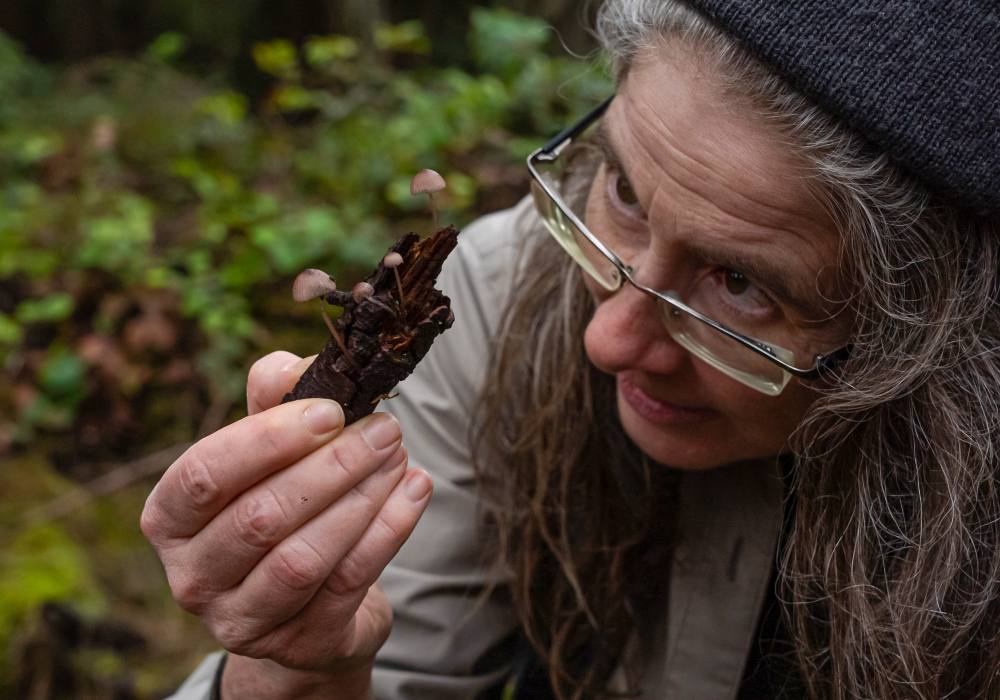
Living separate from the wild world has severed us from our intrinsic Umwelts, Yoon writes. To hone our sense of nature and our place in it, we can begin by learning the names of species around us — much like children do with their first words, or like the taxonomists distinguishing between different species. As BioGaliano has shown, biodiversity thrives in the most unexpected of places: on an escarpment overlooking a channel, alongside the road in a community park, inside a rotten log. Naturalists like Simon can serve as guides to reawaken a dormant Umwelt.
Recall that the second goal of BioGaliano is to rekindle the intrinsic joy found in the wild world. “People really care about what they see — what they experience,” says Kevin Toomer, a BioGaliano participant. “Small things that I wouldn’t have placed much importance in before have more importance to me now.” Toomer says that since he’s known Simon, he has developed an especially heightened awareness of bees and, of course, mosses and lichens.
“If you learn the name of a bird — a robin, a varied thrush, or what have you — you’ve learned a word and you can begin to talk about that creature, and people that don’t know those words can’t,” says Goward. “While the Oxford people are trying to take words out, Simon is trying to put words in.”
Yet BioGaliano is more than a field-based immersion into nature’s who’s who. Returning wild words to our vocabularies also serves as a gateway to understanding nature’s complexity.
Evening is falling, and the BioGaliano team conglomerates at the Galiano Community Hall, a small, shake-shingled building where folding tables have been set up near electrical outlets to power the microscopes. Simon has ordered pizzas for everyone, and the naturalists unpack samples stashed in brown paper bags and begin working at identifying the specimens.
Janszen slips the slime mould she collected under a dissecting microscope and brings it into focus, revealing spherical heads atop hair-thin stems. The black bobbleheads are decorated with a corona of light-brown speckles, their netted pattern revealing that the species is Cribraria vulgaris. It has been found around the world, but this is the first record of it on Galiano Island. The BioGaliano list grows longer by one more name.
It will take weeks, perhaps even months, to review and identify the dozens of samples taken in the blitz. Preliminary results indicate that, in a single day’s effort, the team confirmed the continuing presence of seven species historically found on the island, and added 25 new species to the overall list. Five are new to B.C., four of those are also new to Canada, two are new to all of North America, and one is even new to the Americas. This last species, a fungus, had previously only been found in Russia.
Throughout Simon’s adventures in species seeking, he’s been teased by the possibility that BioGaliano will identify a life form entirely new to science. If and when that happens, Simon — or whichever of his naturalist friends makes the discovery — will be in the rarefied position of distinguishing the finding with a name.
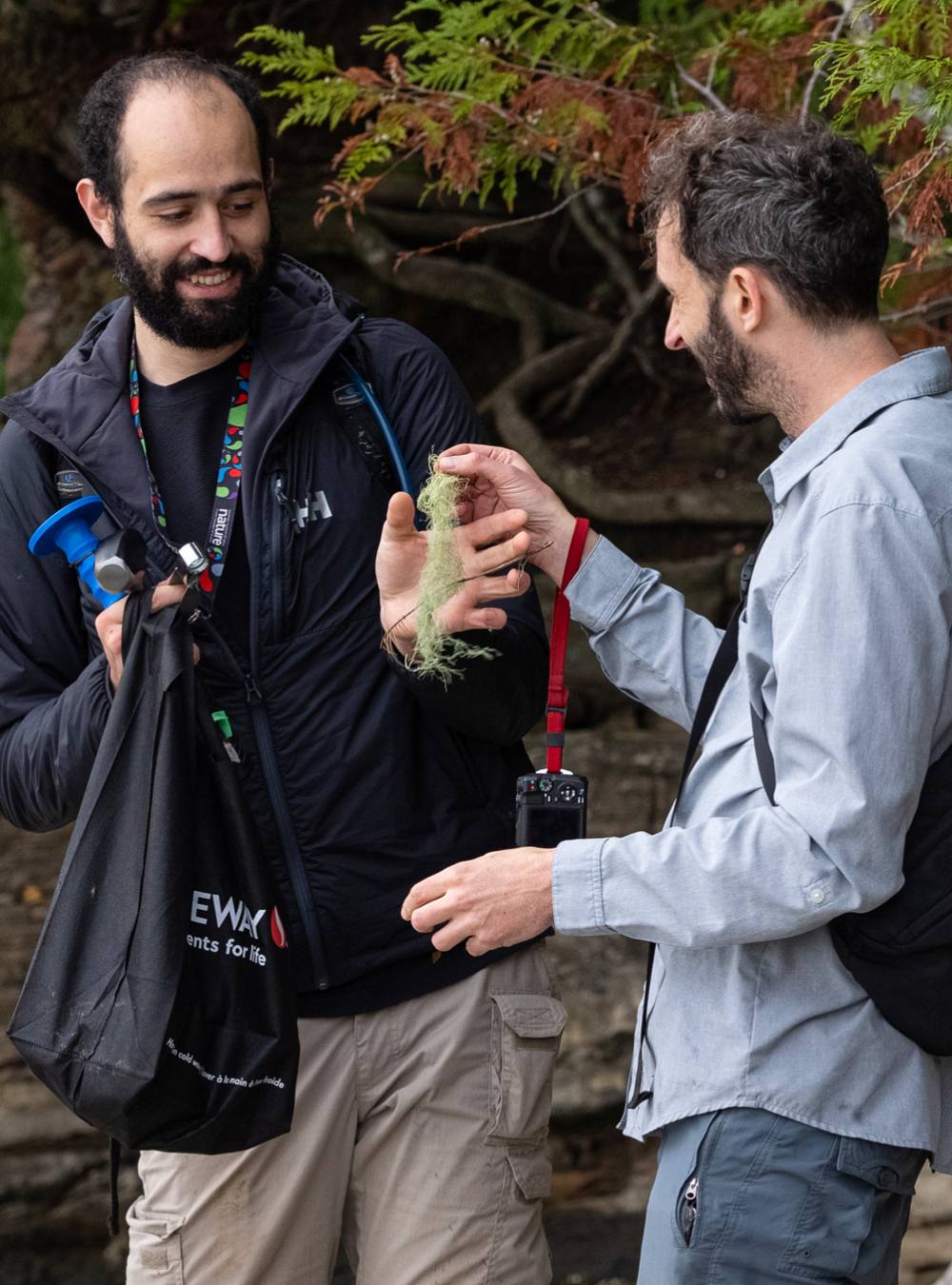
On a philosophical level, naming is imbued with power. Naming is an act of claiming, and more often than not reflects the worldview of the namer rather than the named.
“In naming an individual animal or a species, we not only choose how we want to represent that animal, but also how others are to represent and perceive it,” writes Sune Borkfelt, an animal studies and literature scholar at Aarhus University in Denmark. “We lay the foundations of representations and perceptions to come.” The roly-poly bug, for instance, brings to mind a more congenial image than the red-eye medusa, though neither animal is necessarily endearing: the former is a type of wood louse and the latter a jellyfish.
According to Borkfelt, the names we bestow can also bring us closer to or distance us from species. Perhaps the most anthropocentric are names taken from influential Europeans in the past — Anna’s hummingbird, Steller’s jay, Scouler’s willow.
A more ecological worldview is reflected in names that describe the species itself. In Hul'q'umi'num, the language historically spoken by the Indigenous people of Galiano Island, alder is kwulala'ulhp, roughly meaning “orange plant” for the tree’s tangerine inner bark. Oregon grape is luluts'ulhp, meaning “yellow plant” for the bush’s bunches of sunny blossoms. Many scientific names are descriptive as well. For the Pacific gopher snake, Pituophis catenifer, its epithet refers to the chain-like pattern that adorns the serpent’s back.
Simon is formalizing BioGaliano’s findings in the scientific literature by publishing a series of papers, and later this year he will start a PhD program with UBC researching biodiversity data science. He recognizes, though, that he still has heaps left to find on Galiano Island and that his growing list of identified species is only a starting point.
“These names are all just like the words in a sentence,” Simon tells me. “To really appreciate a place and its ecology, it’s about learning how those words fit together.”
His words remind me of another discovery that came out of the October foray. Simon and Alejandro Huereca Delgado, a specialist in fungal parasites of lichens, had collected a speckle that looked like a coarse-ground pepper flake entangled in a tuft of mint-green fibers. Under closer inspection, it proved to be much more — a composite of at least four different species: an alga and a fungus hosting a fungus hosting yet another fungus.
Ecology can live within language as much as landscape. ![]()
Read more: Science + Tech, Environment


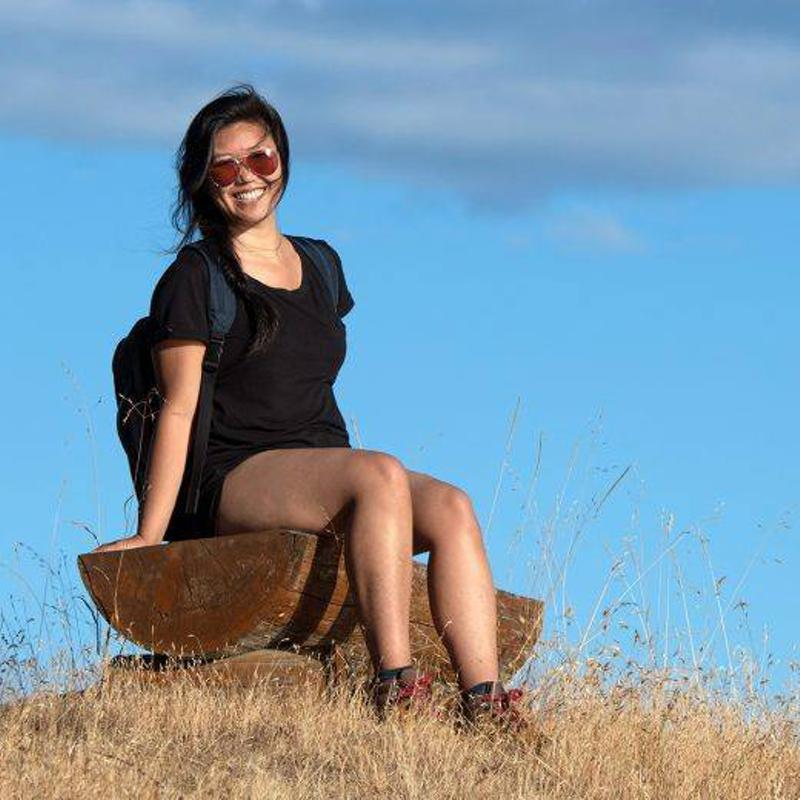

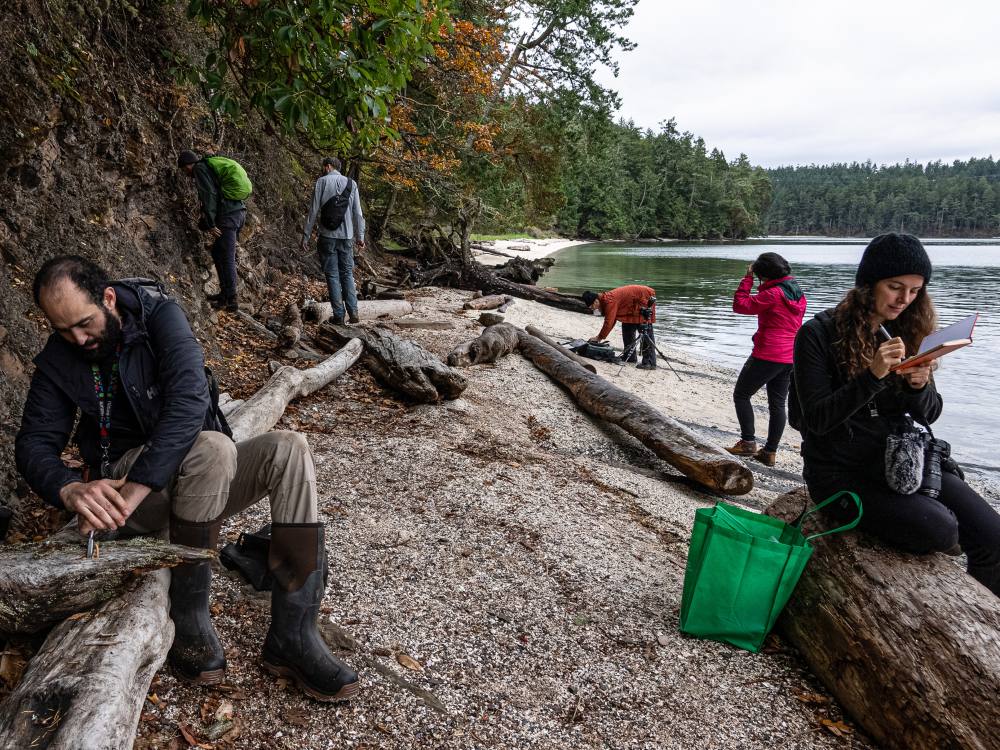












Tyee Commenting Guidelines
Comments that violate guidelines risk being deleted, and violations may result in a temporary or permanent user ban. Maintain the spirit of good conversation to stay in the discussion.
*Please note The Tyee is not a forum for spreading misinformation about COVID-19, denying its existence or minimizing its risk to public health.
Do:
Do not: